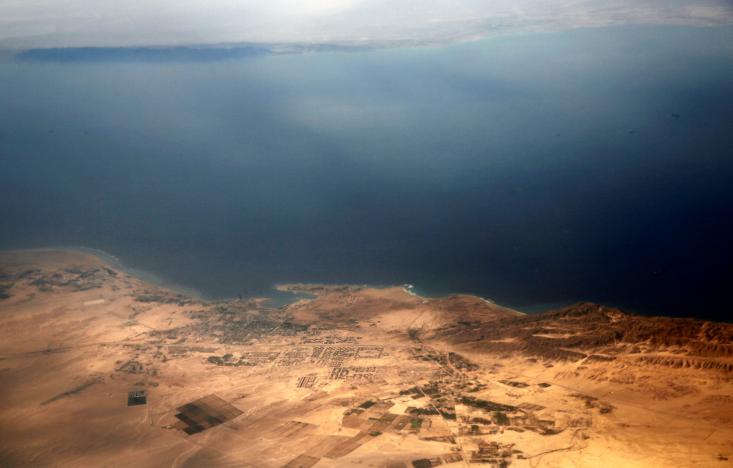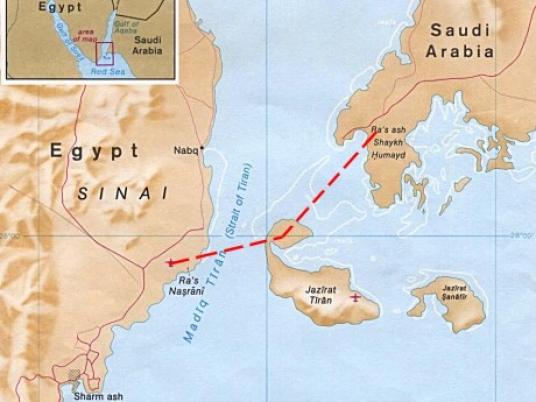
The Saudi Arabian King Salman Bin Abdel-Aziz arrived in Cairo on Thursday, and over the days that followed signed numerous political and economic agreements, including one that revised the maritime borders of Egypt and Saudi Arabia.
To the surprise of parliament and people, the Egyptian cabinet declared that the islands of Tiran and Sanafir — long believed to be under Egyptian sovereignty — in fact lie in Saudi waters.
The Cabinet referred to documents that allegedly give a record of the maritime border demarcation at each point in history, thereby proving the islands' dependency to Saudi Arabia.
The documents point to an agreement settled between Egypt and Saudi Arabia in 1950 that placed the two islands under Egyptian governmental administration for military use. Given the prime strategic location of the islands at the entrance to the Aqaba Gulf, the countries agreed for the islands to be used to strengthen Egyptian military defense in the Sinai Peninsula and to promote the Arab military position against Israel.
According to a cabinet statement, the details of the islands' ownership can be found in letters “exchanged between the Egyptian Foreign Ministry and his Saudi counterpart about the two islands in 1988 and 1989," along with another letter from the Saudi Foreign Minister, "requesting the return of the islands from Egypt to Saudi Arabia when the loan period was over".
Moreover, the Cabinet indicated that in 1950, a secret telegram had been sent by the US ambassador in Cairo to the US Secretary of State underlining that the islands of Tiran and Sanafir belonged to Saudi Arabia. The telegram detailed that Egypt had taken control of the islands to protect them from Israeli attacks in coordination with Saudi Arabia. The agreement was reached as a form of aid to Saudi Arabia from Egypt.
Nonetheless, the agreement will be handed over to the parliament to be discussed and ratified, in line with constitutional considerations.
From the Saudi side, minister of foreign affairs for Saudi Arabia, Adel Algebier, stated that “each country has the right to draw its borders with neighboring countries, and we have successfully done that with Egypt in a way that satisfied both sides.”
He put this is the context of Saudi Arabia's wider project to settle its maritime border demarcation, confirming that the kingdom has recently reached border agreements with countries including Qatar and Iraq.
The cabinet indicated that the agreement will allow Egypt to use shared Red Sea waters for excavation of natural resources, which will boost the Egyptian economy.
Timeline
Tiran and Sanafir are located at the southern entrance to the Gulf of Aqaba, in the north of the Red Sea.
In 1906, the Ottomans drew the eastern borders of their Empire, placing the Gulf of Aqaba and Eilat outside the limits of the Egyptian border as defined under Ottoman occupation. This contradicted the border line demarked by official documents in 1840, and sparked controversy on the Sinai Peninsula.
During that time, a major part of the Egyptian public supported the Ottomans, and fears were raised that the British planned to take over Sinai as a base from which to control Palestine and the Hejaz. Therefore, the Ottoman Sultan decided to take over Aqaba and Taba, and after negotiations, Egyptian forces took over Taba and the islands under the watchful authority of their Ottoman occupiers.
Later in the same year, Egypt signed a new border agreement with the Ottomans. Egypt’s border now ran from the Mediterranean coast to the Gulf of Aqaba, and included Tiran and Sanafir.
In 1932 the modern-day Saudi Arabia was established under Ibn Saud out of what had formerly been four distinct regions: the Hejaz, Najd, Eastern Arabia (Al-Ahsa) and Southern Arabia.
In 1949, the first Arab wars against Israel ended under the Rhodes Armistice Agreement, and the islands, along with the Strait of Tiran, were placed under Egyptian control.
In 1950, a dispute arose between Egypt and Saudi Arabia over the islands. According to documents (the same documents relied on by the Cabinet for their agreement last week), out of the dispute the mutual agreement was reached that Egypt would keep the islands due to the weakness of the Saudi navy at the time.
In 1951 Egypt banned the free passage of Israeli vessels through the Tiran strait, declaring that any ship wishing to use the waterway must inform the Egyptian authorities.
Egypt notified the United Nations in 1954 that Tiran and Sanafir lay in Egyptian waters and belonged to the country, according to the Ottoman agreement of 1906. They also referred to records indicating that Egyptian forces were on the islands during World War II.
In 1957, Saudi Arabia sent several diplomatic missions to the United Nations to dispute Egypt's ownership of the islands.
As the Six-Day War broke out on 22 May, 1967, Egypt blocked the straits of Tiran for a second time. But defeat for Egypt saw Tiran captured by Israeli forces, and the island remained under their control for the duration of the Israeli occupation of Sinai.
Following the Arab-Israeli War of 1973, Egypt signed the Camp David Accords with Israel, which guaranteed Israel the right to navigate through the Tiran strait and placed watchdogs from the international forces along straits and in Sharm El-Sheikh. The islands were assigned to what was called the 'C' zone.
In 1983, Tiran and Sanafir were declared by the UN as natural reserves.
In 1989, Saudi Arabia again issued a statement to UN asserting that the islands belonged to Saudi Arabia.
In 1990, an Egyptian presidential decree was issued to draw the lines of the Egyptian waters clearly. On January 12, 2010, the Saudi King Abdullah bin Abdul Aziz issued a royal decree demarcating the Red Sea maritime border of the kingdom, Egypt, Jordan and Sudan.
Current controversy
The Cabinet's statement last week concerning Saudi ownership of the islands has provoked a wave of public outrage, some considering the government's move to be a sale of a valuable piece of Egyptian land, and others condemning the decision as unconstitutional.
But amid the confusion of unreliable sources and limp evidence, the question that occupies many remains: are the islands Egyptian or Saudi?
Chairman of the Board of Management at Al-Ahram, Ahmed Sayed El-Naggar, declared Tuesday that the islands will remain Egyptian forever.
Al-Nagar wrote on his Facebook page, “A country is the sum of its land, borders, science, people, rocks and mountains, sand and trees. All these elements deepen ones love, affection and enthusiasm for ones country. Our homeland is not a room for rent; it cannot be taken from us in times of conflict and given back in times of harmony. It is something that grows inside of us and cannot be uprooted by the force of flimsy agreements on paper.”
The Egyptian scholar and author Youssef Zidan mused over what he considers to be the dispute of an axiom. He argued that logically, the two islands are necessarily Egyptian in order for the country to have the authority to hand them over to another country.
Zidan explained that the borders of ancient countries have been demarcated uncountable times, and there are many old maps certifying that the borders as drawn in 1906 were correct. He wondered whether there exists a map — from before the discovery of oil — that shows the islands are not Egyptian.
Echoing Zidan, former governor of South Sinai Abdel Moniem Saied has asserted that the islands are 100 percent Egyptian. “It was a surprise to hear the announcement that the islands are Saudi, when the Egyptian flag had been flying on them for years,” he observed.
"Since graduating from the Military Academy in 1955, I served on Tiran at a time when Egypt had two border points — on the top of the mountain and a helicopter subsidence point. Moreover, Tiran Island is 8 km away from Sharm el-Sheikh's "Beach 8", therefore the islands cannot be Saudi," Saied told Al-Ashera Masaan Talkshow.
Saied underlined that the Island is vitally strategic because it lies at the entrance to the Gulf of Aqaba.
But not all are in opposition to the Cabinet's agreement.
Former parliament member and politician Amr Hamzawy expressed the view that some people simply want to oppose Sisi's government and are therefore turning a blind eye to documents that prove the islands are Saudi.
“The Egyptian government should have talked to the public transparently about the maritime border agreement with Saudi Arabia. Not only that, but they should have released the documents drawn up by the committee in charge of the initial border project of 2010. The government should have clearly made known that the islands were administrated by Egypt as of 1950 under the consent of Saudi Arabia,” he said.
Hamzawy concluded that despite the lack of transparency on the Cabinet’s part, their statement seemed accurate as the decision was based on thorough measurements of land and sea limits of the two countries, and drew on reliable documents indicating that both islands lie inside Saudi waters.
"What is more, the statement accurately referred to the notification of the United Nations in 1990 when Egypt's maritime borders were set, wherein Egyptian sovereignty over the islands was disclaimed.
Hamzawy cited on twitter several academic and legal studies affirming that Egypt had never owned Tiran and Sanafir.
Alaa Yousef, the official spokesperson of the Egyptian president, celebrated the agreement as a landmark achievement. Speaking to Radio 9090, Youssef said that the agreement would enable both countries to benefit from an economic zone rich in resources.
“Negotiations over this maritime border have been going on for six years, after Saudi Arabia's request to the United Nations in 1990. The demarcation stated that the islands of Tiran and Sanafir lie within the territorial waters of Saudi Arabia, and there was an agreement between both countries to benefit from the island," said Yousef.
Meanwhile, security and strategic expert Zakaria Hussien told Egypt independent, “Egypt is not ready to give up any of its land. The islands are Saudi Arabian and they were only administrated by Egypt upon the approval of the Saudi Arabian King during the war against Israel. This was mentioned in official correspondence between the countries, and the United Nations was notified,” he said, adding that the rightful borders were drawn up using advanced technology in 1990.
Hussien praised the agreement, saying that it will tighten relations with the Saudi Arabians.




